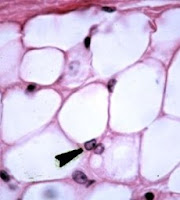Understanding adipocytes, fat cells (English: adipocyte, lipocyte, lipoblast, fat cells) are cells that serves as a granary fat. Adipocytes are cells that compose adipose tissue and areolar tissue conductor. Highest fat content in adipocytes is kolesteril ester and triglycerides. Secretions produced include resistin, adiponectin, leptin, estradiol, angiotensin and cytokines, interleukins.
Although adipocytes can be generated from fibroblasts and mesenchymal stem cells, adipocytes origin constituting adipose tissue is not yet known with certainty. Adipocytes produce and secrete several proteins that act as hormones. Hormones known
as adiponectin, play an important role in the process of inflammation, and atherosclerotic. Adiponectin is one of the many specific factors adipose tissue. Role of adiponectin improve insulin sensitivity and inhibits vascular inflammation. Adiponectin levels in plasma were significantly decreased in subjects with obesity, resistance
insulin, and type 2 diabetes mellitus. Adiponectin plays a role in modulating insulin sensitivity by stimulating increased use of glucose and fatty acid oxidation through posforilasi and activation of AMPK in muscle and liver. Adipocytes produce and secrete several proteins that act as hormones. Hormones are responsible for the regulation of energy intake and expenditure. Hormone known as adiponectin, play an important role in the process of inflammation, and atherosclerotic.
Adiponectin is one of the many specific factors adipose tissue. Role of adiponectin improve insulin sensitivity and inhibits vascular inflammation. Adiponectin is inversely related to leptin. Adiponectin levels in plasma were significantly decreased in subjects with obesity, insulin resistance, and type 2 diabetes mellitus. Levels of this hormone increases after weight loss. Two case-control studies of the Pima Indians and Caucasians healthy concluded that low levels of plasma adiponectin are associated with increased risk of type 2 diabetes mellitus. Hipoadiponektinemia contribute to insulin resistance and accelerate atherogenesis.
Drop in levels are believed to play a role in the pathogenesis of cardiovascular disease associated with obesity and other components of the metabolic syndrome. Recent studies also suggest a role of adiponectin in the regulation of insulin action, energy homeostasis, obesity and insulin resistance.

No comments:
Post a Comment